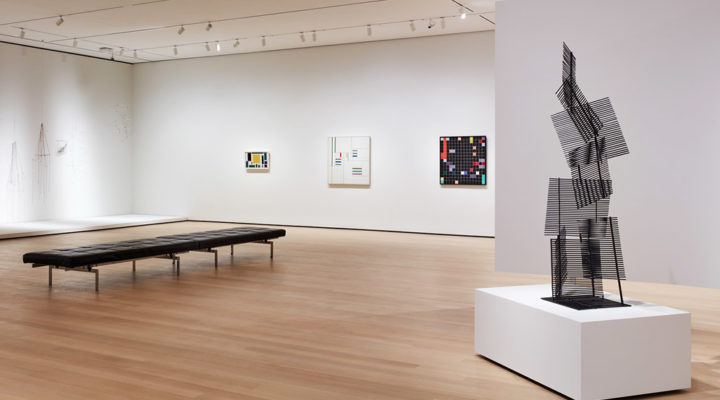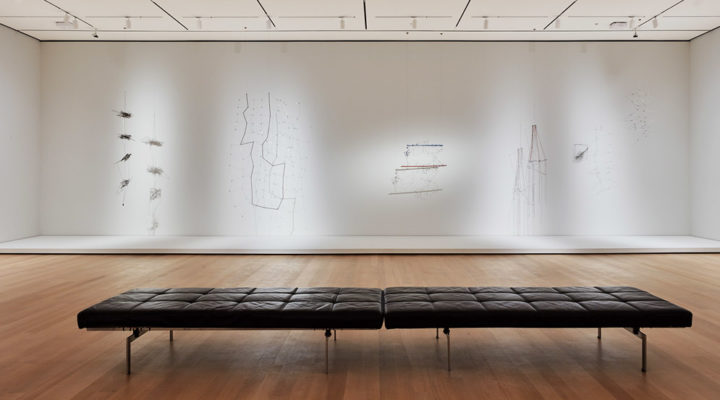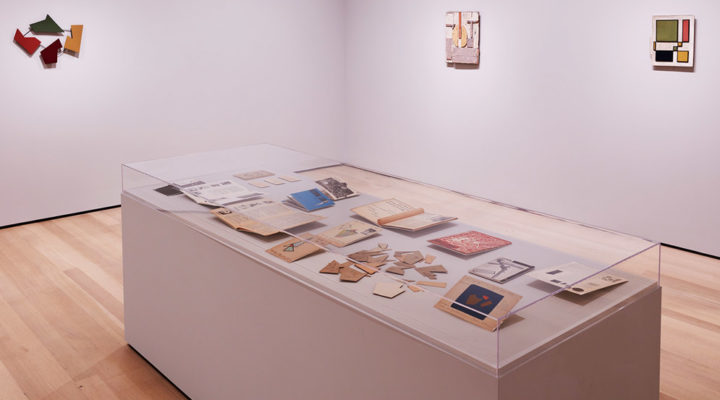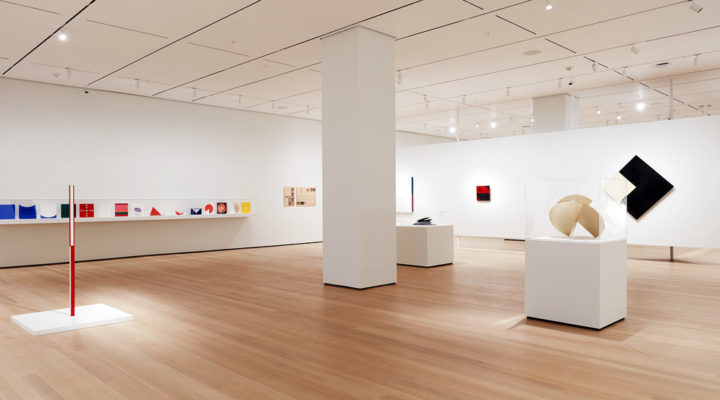SOCIAL SCIENCES AND THE HUMANITIES
CONICET scientist is consulting curator of a Latin American art exhibition at the MoMA in New York
María Amalia García, expert on South American constructivism, was called to work in one exhibition that will be until March 2020.
The first time María Amalia García visted the Museum of Modern Art in New York (MoMA) was when she was 17 and was on holidays with her family. There she saw an art exhibition called Latin American Artists of the Twentieth Century. Although some years later she obtained her degree in History of Art and became CONICET researcher, she did not imagine that that exhibition was going to be a key link in the American art history as regards the definition of ‘what is Latin American,’ and her career as a scientist. Several times García would verify the definition of that exhibition. Now, Garcia came back to the MoMA called as consulting curator of the exhibition on Latin American art called ‘Sur Moderno: Journeys of Abstraction –The Patricia Phelps de Cisneros Gift,’ which was inaugurated on October 21th 2019 and would be until March 14th 2020.
“I’ve never imagined that I was going to be the curator of an exhibition here. When Inés Katzenstein, Curator of Latin American Art at the MOMA called me, it was not only a great challenge but also an intense learning and work process,” says the art historian. She is 44 and has focused on the comparative study of concrete art movement, in which the Argentine artist Tomás Maldonado was one of the leading exponents. Apart from Katzenstein as curator organizer of the exhibition and García as curatorial advisor, the team comprises Karen Grimson as curatorial assistant . The three displayed an exhibition on Latin American art with more than 140 pieces donated by Venezuelan collector Patricia Phelps de Cisneros. The pieces belong to what is known as South American constructive abstraction, and the collector has obtained them throughout her life. Within the works, there are interventionist projects from Río de la Plata –Argentina and Uruguay-, Brazilian concrete and neo concrete works and Venezuelan kinetism: all movements García studied throughout her scientific career.
“Working with the pieces that I have always studied is a dream,” García says. The pieces, which were now donated to the MoMA, had been exhibited in different museums in Latin America, the United States, and Europe. In 2003, in Buenos Aires, the public had the possibility to see them in MALBA. Katzenstein and García had ahead the challenge of analyzing the curatorial selections already done and proposing a new way to understand and show the collection. Apart from the contributions of Phelps de Cisneros, the exhibition comprises some pieces from the collection of the MoMA (such as the Broadway Boogie Woogie of Piet Mondrian and Spatial Construction of Aleksandr Rodchenko) and documentation related to groups and cultural processes of the period.
A new order
Until the exhibition, the collection given by Phelps de Cisneros had been shown, broadly speaking, under three organizations: from a chronological order –starting by the first works of constructivism and continuing with its development over time-; with a geographical cut –making a difference between the art from Argentina, Brazil, Uruguay and Venezuela-; and with purely formalistic criteria. “This time, the aim is to provide this approach with more conceptualization and organization,” García explains.
The experts made a very tight selection of pieces and divided in two sections the exhibition, which is in the Robert B. Menschel Galleries’ room of the third floor of the old building of the MoMA. The first section, called “artworks as artifacts – artworks as manifestos,” the curators grouped the pieces considering the body of the objects, that is to say, the challenges the work proposes from its material structure. This section refers to pieces that question the canonic concept of work of art: paintings that break frameworks cut and fold the surface; works that activate the edges of the frame or that uncover their structure; works that in its first exhibition invited visitors to manipulate or transform them. This first section included pieces of Brazilian neo-concretism (“Cuts and folds”), of Venezuelan kinetism, Sao Paulo concretism (“Unsteady optics”), and Argentine inventionism (“A revolution of limits”). Beyond this general organization, the exhibition sought to stress regional ties, therefore, each part shows the bonds between the studies of the different artists of the region.
In the second section, called “Modern as abstract,” the curators wanted to work the concept of institutionalization of abstraction from the 50’s. “In this part, we aimed at showing the meaning of the institutionalization of this tendency in the field of art; this goes beyond the museum inscription; it is linked to the projection of the abstraction like a language that extends not only to artistic research –in the use of series and grids, for instance– but also to the environment and the city through architecture and design. In this sense, a central core of this main point was the idea of the outdoors intervention and the artist´swork involved with architecture, design and landscape design.. We included three emblematic chairs of South American modern design, photographs of the building of Brasília, a city icon of the trend known as ‘synthesis of arts,’ and another paradigmatic example, like the city of Caracas, which was conceived by Carlos Raúl Villanueva”, García explains. “This material can be seen in the showcases where we included documents and photographs to contextualize and deepen some aspects of these episodes.”
Comparative perspective
How did the researcher manage to curate an exhibition on concretism in the MoMA? Early in her academic career, García focused on the problem of design linked to plastic arts. She studied the figure of the Argentine artist Tomás Maldonado, who is a central exponent on that subject as he was a pioneer in the local concrete art movement, a trend that sought to overcome abstract art in function not to remove elements from reality but to focus on the search for the specific aspects of visual arts –the lines, the colors, the planes, the space– “One example is the work of the Brazilian artist Waldemar Cordeiro, who is present in the exposition and posed the need to understand the canvas as a defined space where the composition is a test of interdependences,” García explains.
As concrete art was widely adopted by South American artists, García decided to explore the subject in regional terms instead of limiting it by countries, as national historiographies had done at the time. In order to study it regionally, García analyzed journals –and other sources– as key support for the dissemination and projection of these ideas. “Although the relationships between the Argentine artists and the constructivism of Joaquín Torres-García in Uruguay had already been analyzed, I found that the links with Brazil were unknown,” says the researcher. She managed to verify that in the same years in Argentina as well as in Brazil there was simultaneous interest of artists in concrete art and it was worth thinking and studying them in an articulated way. Nevertheless, both countries were going through different socio-political contexts: in Argentina, in the 40’s, the abstraction did not have the institutional support of the Peronist government whereas in Brazil, the State and fundamentally the private sector promoted new cultural vanguard groups.
In 2010, García continued to deepen the comparative studies. She had the possibility to travel to Paraguay and analyze from the archival material –photographs, newspaper clippings, magazines– the incidence of the diplomatic actions Brazil took in cultural and artistic terms from the end of the Second World War, which made Buenos Aires gradually lose the cultural supremacy of the region. “Paraguayan artists historically had come to Buenos Aires to study and considered Argentina as South American paradigm in terms of culture. However, after the second postwar period, Brazil advanced as a model of cultural and education management, causing great tension in the regional hegemonies,” García describes.
The experience in Paraguay was followed by a stay in Colombia. “In general, there is a tendency to circumscribed studies by countries. I had always been interested in relating the proximities between the phenomena of modern art in different countries and analyze and compare according to the theoretical-methodological comparative frameworks. A comparative study allows us not to artificially cut events: people; artists who travel, interact, work on the same interests, share references, ideas.” García analyzes the idea that in cultural terms, the phenomena do not have national geographical limits. “Regional stories stress contacts, trips, exiles, publications, exhibitions, etc in order to construct a more comprehensive story and not limited to a cut per countries that is in several senses artificial for cultural phenomena. In my opinion, for those who do research, it is very positive in terms of breadth of interpretations.”
So the exhibition at the MoMa works as sort of synthesis of the research work she has undertaken during these years as a CONICET scientist. “I would like the viewers to enjoy the exhibition, have a good time and appreciate the creativity of each artist and the diversity of each movement, and above all, I want specialized public to perceive the difference proposed by one exhibition whose curatorial conception a researcher is involved. We, researchers, can provide rigor and conceptual density to curatorships and accuracy in the selection of pieces. At the same time, working with curators can make researchers open up paths with more freedom in terms of production, implementation in the exhibition space, and that is technical expertise that only a few researchers have. I really appreciate Inés’ lucidity in having thought this project collaboratively. It would be great to have in the future this work scheme of interaction between researchers and curators in Argentina and in other museums of the world.”
By Cintia Kemelmajer
English version by: Cintia González




